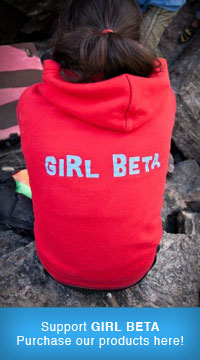The Importance of Hydration for Climbers
by Mercedes Pollmeier
In order to perform at the optimal level in climbing, your body needs to be well hydrated. Water is the basis of our body, about 45 to 70 percent of total body weight, depending on how much muscle mass you have. When our muscles and joints have the optimal amount of water, they can glide and move easily as we participate in our activities.
Water surrounding our muscles also provides the optimal environment for recovery. This is why creatine monohydrate supplementation is so helpful (though I don’t recommend it for most strength-to-body weight ratio sports/activities), because it draws water in and around the muscle tissue. With proper fluid amounts, cellular functions operate at a more efficient pace and allows for wastes and toxins to be flushed out of the cell. If you are dehydrated, you may notice faster muscle fatigue, reduced coordination and muscular cramping.
As a climber, I always found it difficult to stay properly hydrated in the cold and on long approaches. Firstly, no one wants to hike in the extra weight of water, this is why having a purifier is handy, but only if there is a water source near by your crag. Another problem I have encountered with many boulderers and climbers is that drinking water adds body weight, which seems detrimental while trying to crush your problem or route. While this is quite true, it may only add a few ounces at a time as you drink and regularly go to the bathroom. Remember, keeping hydrated while climbing is beneficial for performance on your project and helps with speed of recovery, repairing your muscles and getting them ready for your next training or climbing session.
Tips on staying hydrated: try to take a few sips after every burn and eat fruit while you climb. You don’t only get water from drinking it, you also get it from your foods, specifically fruits and vegetables. There’s another reason to eat your veggies daily! Try to avoid fluids with sugar in them, as this can reverse the hydration process, and this also prevents you from drinking your calories, which, when trying to lose weight, can keep you from reaching your goal weight. About 4 hours before activity you should drink 2 to 3 milliliters per pound of body weight to get your body ready and in proper water balance (“Nancy Clark’s Sports Nutrition Guidebook”; Nancy Clark, MS, RD; 2008).
Some symptoms of dehydration: headaches similar to what is experienced during a hangover, decreased blood pressure (hypotension), and dizziness or fainting when standing up due to orthostatic hypotension. One’s heart and respiration rates begin to increase to compensate for decreased plasma volume and blood pressure, while body temperature may rise because of decreased sweating (Wikipedia, 2012).
8 Reasons Why Women Should Lift Weights
Great article about the general reasons for why women should lift weights. Lifting will also benefit your climbing, as it can be used as injury prevention, improve weaknesses and maintain strengths. Are you ready to lift some heavy things!?
Rocky Mountain National Park: Shauna Coxsey
Shauna has been demolishing everything she approaches, and this time it’s Riddles in the Park V12 and Whispers of Wisdom V10.
Shauna Coxsey: Mind Matters, V12. Guenella Pass, CO
A nice video of Shauna working through a long line in Guenella Pass, CO.
Climbing Knots: How to Tie In with a Figure 8 Knot
Climbing Magazineis producing a series of How To videos in 2012 to demonstrate a number of skills and techniques. Using our experienced staff and following AMGA guidelines we’ll show you how to get started in the vertical world. In this video Julie Ellison, Climbing Magazine Gear Editor, shows how to tie a figure 8 knot.Thanks to our partners: Wild Country Red Chili, Vertical Girl, and New England Ropes.
Keep the Video’s Coming!!
The last few posts were made possible by women from around the world who sent their climbing footage in. A big thank you to Detriot Rock Climbing Company for supplying the hang boards that these lovely ladies get to enjoy for their submissions!
Remember, if you submit your video, and it is chosen, you are eligible to win a DRCC hang board, Organic Slider Pad, or some Vertical Girl Clothing, so KEEP’EM COMING!! The video submission period has been extended until May 31st.
» Women’s Climbing – Competition and Motivation by Thomasina Pidgeon
Great article by Thomasina!
A top female climber’s personal reflection on motivation and competition in women’s climbing today.
Personal will and determination are indispensable in climbing. The drive of many psyched climbers and their desire to improve stem from their love of the sport. If you lack the desire to grow as a climber, it doesn’t matter if you are male or female; getting your ass up that project is going to be a chore. Read More…
Spittin’ Venom V9 – Red Rock Canyon
Here is a video submission from Jeline Guiles:
Beta:
- Start with your hands on the two crimp rails at the bottom.
- Use the tiny left foot and a low right heel around the arete.
- Pull up to the first intermediate right crimp, then quickly throw to the higher right crimp. If you’re taller, you can just go straight to the higher right crimp.
- Get a left heel on the start and lock off your right arm. Taller people can toe into the clearly marked left foot below the first starting left hand.
- Fall into the left micro jug.
- Bring your right hand up to the other micro jug on the right side.
- Match your hands and pull up over the lip.
- Reach for the far left jug and top it out.
- Top out holds are numerous, you just have to feel for them
Croft Problem at the Lower Smoking Boulder (V8), Bishop, California
Here is a video submission by Christine Balaz.
Croft Problem at the Lower Smoking Boulder (V8), Bishop, California from Christine Balaz on Vimeo.
*sit start with the right and left hands each on large flakes/ left foot low (backstep), right foot high (in big pocket)
*long left-hand move to good sloper, bump right hand up
*flag left foot behind right
*bump left hand again to gaston
*bring left foot to edge, under body
*move right hand up to 2-finger knob/crimp
*bump right hand up to sloper pocket
*move the right foot up to edge, and then left foot up (into good pocket); this is where beta gets very different for people. Drop knee with left leg
*grab bad sloper/ crimp with left hand (thumb catch is key)
*walk left, then right foot up
*(crux) pop to a good gaston with left hand (make funny noise)
*The problem is pretty much over now; walk feet up, and bring right hand up, then move out to the left
Stephan V7- Little Cottonwood Canyon
Here is Heather Alday climbing Stephan V7. This video features other classics from LCC and Heather starts climbing a bit before the four minute mark. Beta for this climb is listed below
Little Cottonwood Canyon Classics – Episode 1 from Wagon Productions on Vimeo.
Beta:
Begin low on obvious start holds, left foot low on good hold, edge right foot in crack just left of the more noticeable foot hold. (this will give you extra reach)
Pull off the ground and move right hand to undercling then left hand to 1st crimp rail, left foot up near start hold.
Bump left hand (big move) to 2nd crimp rail. Right foot up to point.
Match hands on crimp rail.
Right hand extends up to the lip, left foot up to crimp, left hand finds a fairly good edge on the left side of the lip. Bring feet up, throw right foot over lip and top out
Analytics Plugin made by VLC Media Player






